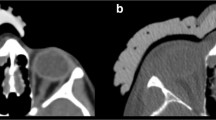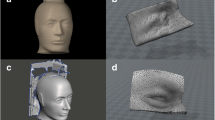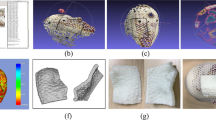Abstract
Bolus plays an important role in the radiation therapy of superficial lesions and the application of 3D printing to its design can improve fit and dosimetry. This study quantitatively compares the fits of boluses designed from different imaging modalities. A head phantom was imaged using three systems: a CT simulator, a 3D optical scanner, and an interchangeable lens camera. Nose boluses were designed and 3D printed from each modality. A 3D printed phantom with air gaps of known thicknesses was used to calibrate mean HU to measure air gaps of unknown thickness and assess the fit of each bolus on the head phantom. The bolus created from the optical scanner data resulted in the best fit, with a mean air gap of 0.16 mm. Smoothing of the CT bolus resulted in a more clinically suitable model, comparable to that from the optical scanner method. The bolus produced from the photogrammetry method resulted in air gaps larger than 1 mm in thickness. The use of optical scanner and photogrammetry models have many advantages over the conventional bolus-from-CT method, however workflow should be refined to ensure accuracy if implemented clinically.




Similar content being viewed by others
References
Khan FM, Gibbons JP (2010) The physics of radiation therapy. Lippincott Williams & Wilkins, Philadelphia, p 137
Canters RA, Lips IM, Wendling M (2016) Clinical implementation of 3D printing in the construction of patient specific bolus for electron beam radiotherapy for non-melanoma skin cancer. Radiother Oncol 121(1):148–153
Zou W, Fisher T, Zhang M et al (2015) Potential of 3D printing technologies for fabrication of electron bolus and proton compensators. J Appl Clin Med Phys 16(2):4959
Zhao Y, Moran K, Yewondwossen M et al (2017) Clinical applications of 3-dimensional printing in radiation therapy. Med Dosim 42(2):150–155
Mac Nally C, Woodings S (2012) Changes to dose at surface and shifts of dose distributions at depth through dry and wet wound dressings for photon and electron beam radiotherapy. Australas Phys Eng Sci Med 35(2):245–250
Butson MJ, Cheung T, Yu P, Metcalfe P (1999) Effects on skin dose from unwanted air gaps under bolus in photon beam radiotherapy. Radiat Meas 32(2000):201–204
Khan Y, Villarreal-Barajas JE, Udowicz M et al (2013) Clinical and dosimetric implications of air gaps between bolus and skin surface during radiation therapy. J Cancer Ther 4:1251–1255
Kong M, Holloway L (2007) An investigation of central axis depth dose distribution perturbation due to an air gap between patient and bolus for electron beams. Australas Phys Eng S 30(2):111–119
Charles P, Crowe SB, Kairn T et al (2012) The effect of very small air gaps on small field dosimetry. Phys Med Biol 57(21):6947
Charles PH, Cranmer-Sargison G, Thwaites DI, Kairn T, Crowe SB, Pedrazzini G, Aland T, Kenny J, Langton CM, Trapp JV (2014) Design and experimental testing of air slab caps which convert commercial electron diodes into dual purpose, correction-free diodes for small field dosimetry. Med Phys 41(10):101701
Charles PH, Crowe SB, Kairn T, Kenny J, Hill B, Knight RT, Langton CM, Trapp JV (2013) Monte Carlo based diode design for correction-less small field dosimetry. Phys Med Biol 58(13):4501–4512
Charles PH, Cranmer-Sargison G, Crowe SB, Kairn T, Thwaites DI, Trapp JV (2014) A diode for correction-less small field output factor measurements. Australas Phys Eng S 37(1):200–201
Perrett B, Charles PH, Markwell T, Kairn T, Crowe SB (2017) Feasibility of 3D printed air slab diode caps for small field dosimetry. Australas Phys Eng S 40(3):631–642
Kong Y, Yan T, Sun Y et al (2019) A dosimetric study on the use of 3D-printed customized boluses in photon radiotherapy: a hydrogel and silica gel study. J Appl Clin Med Phys 20(1):348–355
Park SY, Choi CH, Park JM et al (2016) A patient-specific polylactic acid bolus made by a 3D printer for breast cancer radiation therapy. PLoS One 11(12):e0168063
Kim SW, Shin HJ, Kay CS, Son SH (2014) A customized bolus produced using a 3-dimensional printer for radiotherapy. PLoS One 9(10):e110746
Lukowiak M, Jezierska K, Boehlke M et al (2016) Utilization of a 3D printer to fabricate boluses used for electron therapy of skin lesions of the eye canthi. J Appl Clin Med Phys 18(1):76–81
Su S, Moran K, Robar JL (2014) Design and production of 3D printed bolus for electron radiation therapy. J Appl Clin Med Phys 15(4):194–211
Chlebik AA, Wong K, Clark DL, Olch AJ (2017) Customized bolus for orbital tumors created with 3D photogrammetry and rapid prototyping. Int K Radiat Oncol 99(2):38–39
Milewski C, Peet SC, Sylvander SR, Crowe SB, Kairn T (2019) Optimising a radiotherapy optical surface monitoring system to account for the effects of patient skin contour and skin colour. IFMBE Proc 68(3):451–454
Douglass MJJ, Santos AMC (2019) Application of optical photogrammetry in radiation oncology: HDR surface mold brachytherapy. Brachytherapy S1538–4721(19):30095–30099
Dipasquale G, Poirier A, Sprunger Y et al (2019) Improving 3D-printing of megavoltage X-rays radiotherapy bolus with surface-scanner. Radiat Oncol S1538–4721(19):30095–30099
Acknowledgements
This work was supported by a MNHHS-funded Herston Biofabrication Institute program grant.
Author information
Authors and Affiliations
Corresponding author
Ethics declarations
Conflict of interest
The authors declare that they have no conflict of interest.
Additional information
Publisher's Note
Springer Nature remains neutral with regard to jurisdictional claims in published maps and institutional affiliations.
Rights and permissions
About this article
Cite this article
Maxwell, S.K., Charles, P.H., Cassim, N. et al. Assessing the fit of 3D printed bolus from CT, optical scanner and photogrammetry methods. Phys Eng Sci Med 43, 601–607 (2020). https://doi.org/10.1007/s13246-020-00861-8
Received:
Accepted:
Published:
Issue Date:
DOI: https://doi.org/10.1007/s13246-020-00861-8




